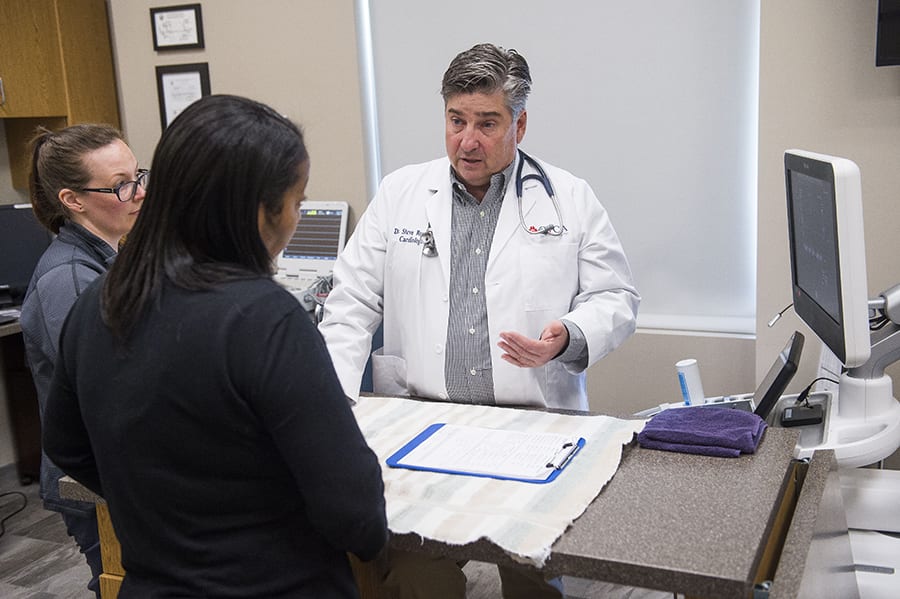Benefits of Early Diagnosis With a Board Certified Veterinary Cardiologist}
Wiki Article
What You Need to Learn About Veterinary Providers: A Summary of Diagnostic Devices and Procedures
Veterinary solutions play an essential duty in preserving the health of family pets. Regular examinations can disclose surprise health and wellness problems early on. Various diagnostic devices and treatments, such as blood tests and imaging methods, provide important understandings into a pet's wellness. Comprehending these methods is vital for pet dog proprietors. What details diagnostic procedures are most frequently made use of, and exactly how can they affect an animal's therapy plan?Importance of Routine Vet Examinations
While numerous animal owners might take too lightly the relevance of regular vet check-ups, these consultations are necessary for maintaining a pet's overall health and wellness. Regular brows through to the veterinarian permit for very early detection of prospective health problems before they escalate into significant issues. Normal examinations usually consist of vaccinations, which are important for protecting against contagious illness that might drastically influence an animal's wellness. In addition, these consultations provide a chance for vets to examine the animal's weight, oral health, and general problem, making certain that the pet is thriving. Throughout these gos to, family pet proprietors can additionally obtain beneficial guidance on diet regimen, exercise, and preventive care customized to their particular family pet's needs.Typical Analysis Procedures in Vet Medication
In veterinary medication, exact medical diagnosis is crucial for efficient therapy. Common diagnostic treatments consist of blood testing strategies, advanced imaging modern technologies, and urinalysis, each playing a significant role in identifying wellness problems. Comprehending these methods improves the capacity to offer suitable look after pet individuals.Blood Examining Methods
Blood testing methods function as vital analysis tools in vet medicine, allowing veterinarians to assess the health and wellness of animals properly. These methods include collecting blood samples to assess numerous elements, such as red and white blood cells, platelets, and biochemical pens. Typical examinations consist of total blood counts (CBC), which review total wellness and spot infections, and biochemical panels, which assess body organ function and metabolic standing. Additionally, serological tests can recognize details diseases via antibody detection. Blood screening is minimally intrusive and gives essential details that helps in detecting conditions, keeping track of wellness status, and examining responses to therapies. Overall, these methods play a vital duty in making sure perfect look after family pets and livestock alike.Imaging Technologies Utilized
Analysis imaging innovations are necessary devices in veterinary medicine, complementing blood screening techniques by giving visual understandings into a pet's internal structures. Usual imaging techniques consist of X-rays, which work for examining bone cracks and identifying foreign items, and ultrasound, which permits real-time visualization of soft cells and body organs. Magnetic vibration imaging (MRI) supplies comprehensive pictures of complicated physiological areas, particularly in neurological analyses. Calculated tomography (CT) provides cross-sectional images, enhancing diagnostic accuracy for different conditions. Each of these innovations help vets in identifying ailments, intending therapies, and monitoring recovery. By incorporating imaging modern technologies, veterinary professionals can much better analyze a pet's health and wellness and make educated choices regarding their care.
Urinalysis and Diagnostics
Urinalysis works as a crucial diagnostic tool in vet medication, offering valuable insights right into a pet's total health and wellness and aiding in the discovery of numerous problems. This non-invasive procedure analyzes pee examples to evaluate kidney feature, hydration standing, and metabolic problems. Usual parts taken a look at include details gravity, pH degrees, sugar, healthy proteins, and the visibility of blood or bacteria. Uncommon searchings for can indicate concerns such as urinary system tract infections, diabetic issues mellitus, or kidney illness. To boost diagnostic accuracy, urinalysis is often executed in combination with other examinations, such as blood work and imaging studies. Early detection via urinalysis can lead to timely interventions, boosting the prognosis for numerous vet individuals. It is an important aspect of complete vet care.Comprehending Blood Examinations and Laboratory Analysis
Understanding blood tests and lab evaluation is important in vet medication as it aids in detecting various wellness conditions in animals. Different kinds of blood tests supply important details about an animal's inner state, while translating lab results requires careful consideration of countless factors. This section will check out the types of blood tests readily available and the significance of their results.Kinds of Blood Examinations
Blood tests play a vital duty in veterinary medication, providing important insights into an animal's health and wellness standing. Numerous kinds of blood examinations are made use of, each offering various objectives. Full blood matters (CBC) analyze general health and wellness and identify problems such as anemia or infection. Biochemical accounts examine body organ feature by gauging enzymes and electrolytes, providing insights into metabolic health. Serological examinations recognize details antibodies or virus, helping in the diagnosis of infections or autoimmune illness. Blood typing guarantees risk-free transfusions, while coagulation tests determine the blood's capacity to embolisms, crucial for procedures. These examinations jointly improve diagnosis, treatment planning, and monitoring of an animal's wellness, showing the significance of comprehensive lab analysis in veterinary care.
Translating Laboratory Outcomes
A thorough analysis of laboratory outcomes is essential for accurate medical diagnosis and treatment in veterinary medication. Interpreting lab results needs an understanding of regular reference varieties and the value of deviations. Blood tests can reveal different health and wellness signs, such as organ feature, electrolyte equilibrium, and the presence of infections. Veterinarians must think about the whole clinical picture, including the animal's background, checkup findings, and any kind of signs and symptoms presented. Variations in results might arise from elements such as age, breed, and underlying health conditions. Lab outcomes need to not be watched in seclusion but rather as component of a comprehensive analysis approach. Exact interpretation allows for tailored treatment plans and better outcomes for veterinary patients.Imaging Techniques: X-rays, Ultrasounds, and Beyond
Imaging techniques are important devices in veterinary medicine, providing vital insights right into the wellness and well-being of pets. Amongst the most typically used techniques are Ultrasounds and x-rays. X-rays are indispensable for envisioning bone structures, aiding veterinarians determine fractures, lumps, or foreign things. This technique is quick and non-invasive, making it excellent for urgent situations.Ultrasounds, on the other hand, make use of acoustic waves to produce photos of soft tissues and organs. This technique is specifically helpful for examining the heart, abdomen, and reproductive body organs, enabling vets to assess conditions like fluid build-up or body organ abnormalities.Beyond X-rays and ultrasounds, progressed imaging methods such as computed tomography (CT) and magnetic resonance imaging (MRI) are significantly utilized in vet technique. These approaches supply in-depth cross-sectional photos, enhancing the accuracy of medical diagnoses and therapy plans. CT Scans For Animals. In general, imaging methods play a vital role in guaranteeing reliable vet treatmentThe Role of Biopsies in Diagnosing Family Pet Wellness Issues
Precision in diagnosing wellness problems in pets commonly pivots on the use of biopsies, which supply definitive info regarding tissue problems. A biopsy includes the elimination of a small sample of tissue for examination under a microscopic lense, permitting vets to recognize numerous conditions, including infections, growths, and inflammatory illness. This analysis device is essential for comparing malignant and benign developments, directing therapy decisions, and examining the intensity of a condition.Biopsies can be performed using various techniques, such as needle aspiration, incisional biopsies, or excisional biopsies, depending on the place and sort of cells entailed. The selection of method may affect healing time and the amount of cells accumulated. Inevitably, the info obtained from a biopsy can result in targeted therapies, improving outcomes for animals dealing with severe wellness obstacles. Vets emphasize the significance of this procedure in accomplishing exact diagnoses and efficient therapy strategies.Advanced Diagnostic Equipment: Endoscopy and CT Checks

Advanced diagnostic tools, such as endoscopy and CT scans, play an important duty in contemporary vet medicine, using non-invasive approaches to imagine inner structures and detect different conditions in pet dogs. Endoscopy involves making use of a versatile tube geared up with a camera, enabling vets to analyze the stomach system and breathing system directly. This strategy can reveal problems such as growths, international bodies, or swelling, enabling targeted therapy click for more info plans.CT scans, on the other hand, make use of innovative imaging technology to produce detailed cross-sectional pictures of the body (Cancer Veterinary Near Me). This technique is particularly beneficial for evaluating facility frameworks like the brain, back, and joints. By providing high-resolution images, CT scans help vets in recognizing concerns that may not be noticeable through typical radiography. Together, these sophisticated tools enhance diagnostic precision, improve treatment end results, and ultimately add to much better total pet health and wellness monitoring

Translating Test Outcomes: What Pet Owners Need To Know
Comprehending examination results can be her explanation a tough task for pet dog owners, particularly after advanced treatments like endoscopy and CT scans have been done. Translating these results calls for a grasp of medical terminology and a clear understanding of what the findings indicate regarding the pet dog's health. Vets frequently give explanations, however the complexity of the outcomes can still cause confusion.Pet owners should actively participate in discussions with their vets, asking concerns to clarify any type of unpredictabilities. It is important to comprehend abnormal versus regular results and the implications for the family pet's treatment strategy. In addition, recognizing that some outcomes may need more screening or monitoring can assist owners remain notified concerning their pet dog's health journey. Inevitably, a joint approach between animal proprietors and veterinary specialists cultivates far better health results and enhances the general treatment experience for pets.Frequently Asked Questions
How Do I Choose the Right Veterinary Center for My Animal?
Picking the right veterinary facility entails investigating neighborhood alternatives, assessing certifications, checking out centers, and assessing staff interactions (Board Certified Veterinary Cardiologist). Prioritizing referrals from relied on resources can assist guarantee the best treatment and atmosphere for an animal's health demandsWhat Should I Do if My Family Pet Declines to Go to the Veterinarian?
When a family pet refuses to go to the veterinarian, it's a good idea to continue to be tranquil, usage treats or playthings to attract them, and consider scheduling a home go to if anxiety persists. Patience and favorable support are vital.Exist Telehealth Options for Vet Services?
Telehealth alternatives for veterinary solutions are increasingly available, allowing family pet proprietors to seek advice from veterinarians remotely. These services make it possible for discussions concerning wellness problems, suggestions on minor conditions, and follow-ups without requiring to visit a center.
Exactly how Commonly Should My Pet Have Dental Examinations?
The regularity of dental exams for pet dogs generally depends upon their age and type. Typically, veterinarians advise yearly dental assessments, although some pets might need even more constant sees to preserve perfect oral wellness.
What Are the Prices Connected With Vet Diagnostics?
The costs related to veterinary diagnostics can vary commonly, typically ranging from standard tests like blood work to sophisticated imaging techniques. Elements influencing costs consist of the facility's area, tools utilized, and certain examinations needed for each and every pet dog. Veterinary solutions play an essential duty in maintaining the health and wellness of site web family pets. While several animal proprietors may ignore the importance of routine veterinary examinations, these visits are vital for preserving an animal's general wellness. In addition, these visits provide an opportunity for veterinarians to assess the animal's weight, oral wellness, and total problem, making certain that the pet is prospering. Accuracy in diagnosing health issues in animals typically pivots on the use of biopsies, which provide clear-cut information regarding cells problems. In addition, acknowledging that some results might call for additional testing or monitoring can assist proprietors remain educated regarding their animal's health and wellness journey.Report this wiki page